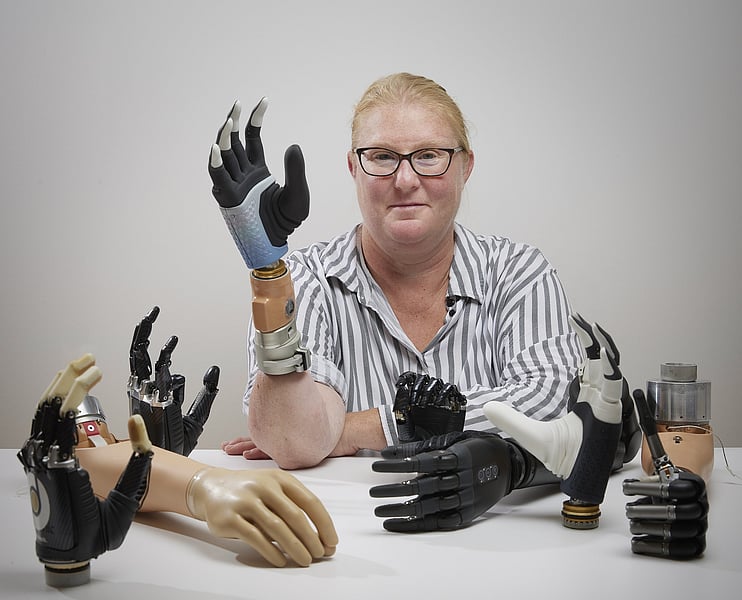Get Healthy!

- Alan Mozes
- Posted October 12, 2023
A Bionic Hand Melds With Woman's Own Bone, Nervous System
Fifty years ago, the TV series "The Six Million Dollar Man"hyped a futuristic world of life-changing bionics with the stirring phrase: "We can rebuild him, we have the technology."
Cut to 2023, and researchers in Sweden appear to have delivered on that promise.
A Swedish woman who lost her right hand in a farming accident more than 20 years ago has successfully been outfitted with a first-of-its-kind bionic appendage, a team of Swedish, Australian, Italian and American researchers reports in the Oct. 11 issue of the journal Science Robotics.
Researchers said the science behind the technology is "groundbreaking,"because the artificial limb has fully integrated with the patient's own nerves, bones and muscles in the years since its attachment in 2017.
The 50-year-old patient, who was identified in a news release touting the study only as "Karin," said the result has been a dramatic improvement in function and much less pain.
Before the novel bionic hand, "it felt like I constantly had my hand in a meat grinder,"she said in a news release from Sant'Anna School of Advanced Studies in Pisa, Italy, one of the universities involved with the research.
Karin had two types of pain: stump pain, where the below-the-elbow amputation had occurred, and phantom pain. That's a common phenomenon in which a patient perceives pain even after the limb is gone.
To deal with it, Karin said she took "high doses of various painkillers."
On top of that, the standard prosthetic devices she had before were uncomfortable and unwieldy.
The new bionic hand has changed all that, according to Karin and a team of Swedish, Australian, Italian and American researchers who developed it.
After the attachment procedure, the intensity of Karin's phantom limb pain has dropped from 5 to 3 on a 10-point pain scale.
And her stump pain -- which once registered a 6 -- is now gone.
"Today I need much less medication," Karin said, adding that she has also gained much "better control over my prosthesis."
Poor control is one of the main problems with standard prosthetic devices, said study leader Max Ortiz-Catalan. He is director of the Center for Bionics and Pain Research in Mölndal, Sweden, and head of neural prosthetics research with the Bionics Institute at St. Vincent's Hospital in Melbourne, Australia.
"There are several sophisticated prostheses, but patients struggle to control all their functions in a reliable and intuitive manner,"Ortiz-Catalan noted.
He added that such devices are typically uncomfortable and/or painful "because they are normally attached to the residual limb using a socket that strongly compresses the skin."
To address these drawbacks, the investigators set out to test the potential of a new robotic hand device developed by Prensilia, an Italian robotics company.
Nicknamed "Mia Hand,"the device was designed to give patients the ability to execute up to 80% of routine everyday activities, the company said.
It is also meant to be aesthetically customizable, to help alleviate some of the stigma people with artificial limbs often face.
Technology makes the Mia Hand a true marvel.
"It is connected directly to the skeleton, using osseo [bone]-integrated implants,"Ortiz-Catalan said.
Over time, bone tissue envelops the titanium in the prosthetic device, resulting in a strong bond between body and bionic.
Those implants, Ortiz-Catalan added, "also serve as a communication getaway between the prosthesis and electrodes implanted in nerves and muscles."
The electrodes collect information about localized nerve control. That information is then transmitted externally to a computer, which uses artificial intelligence software to guide hand use.
The hand is also outfitted with sensors that create sensory feedback between the patient's own nerves and any object that the bionic hand engages with.
The idea is to mesh the patient's nervous system with prosthetic electronics, with an eye to reducing pain and improving control.
The bionic limb is also meant to be user-friendly. Since acquiring her new hand, Karin has been able to easily and independently remove it at bedtime.
Still, she is just the first patient to ever work with "this new concept of a highly integrated bionic hand,"Ortiz-Catalan noted. Research and development continue.
"We are not near the function of a biological limb,"he said.
At the same time, however, Karin's comfortable, effective use of the prosthesis in daily activities "is a promising testament to the potential life-changing capabilities of this novel technology for individuals facing limb loss,"Ortiz-Catalan said.
More information
There's more about bionic devices at the U.S. National Institutes of Health.
SOURCES: Max Ortiz-Catalan, PhD, director, Center for Bionics and Pain Research, Mölndal, Sweden, and head, neural prosthetics research, Bionics Institute, St. Vincent's Hospital, Melbourne, Australia; Sant'Anna School of Advanced Studies, news release, Oct. 11, 2023; Science Robotics, Oct. 11, 2023
